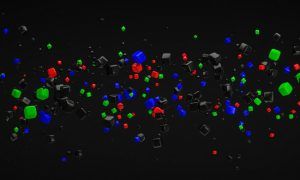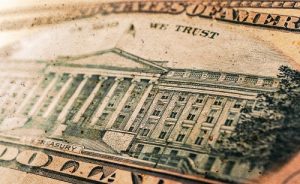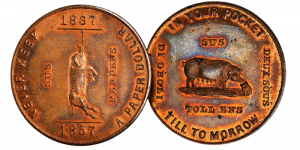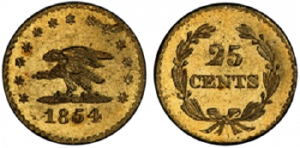This Indian Princess Boasts A Deep Frosty Luster
Posted onA $3 gold coin? During the period the $3 Indian Princess gold coins were minted, from 1854-1889, that represented a hefty sum for everyday Americans.
Americans.
So, why did the U.S. Mint choose to produce a $3 coin? Numismatic experts believe the reason can be found at the post office. When this coin was first minted a U.S. postal stamp cost 3 cents. The $3 coin created a convenient way for businesses to purchase 100 stamps in a single transaction.
Despite its odd denomination, many consider the $3 Indian Princess the most beautiful gold coin struck in the 19th century.
The U.S. Mint’s chief engraver, James B. Longacre designed this coin. In fact, the $3 gold coin was the first time he had been given the freedom to create a design of his own imagination. Longacre wrote that previous to the $3 gold coin, he had been directed to adapt Roman or Greek features into U.S. coins. For the $3 gold coin, Longacre was determined to create something uniquely American.
“From the copper shores of Lake Superior to the silver mountains of Potosi, from the Ojibwa to the Araucanian, the feathered tiara is a characteristic of the primitiveness of our hemisphere as the turban is of the Asiatic,” Longacre wrote.
He was inspired to feature an “Indian Princess” on the obverse of this stunning coin. A lustrous orange-gold color, the coin shows a gorgeous Indian Princess adorned with a feathered headdress, with the words UNITED STATES OF AMERICA circling her. On the reverse, the date and denomination is surrounded by an agricultural wreath celebrating corn, tobacco, cotton, and wheat.
Minted in Philadelphia of 90% gold and 10% copper, a total of 82,304 were produced in 1878. Survival estimates for all grades totals 25,000, yet for grades 60 or better only 6,000.
Blanchard recently placed an 1878 $3 Indian Princess MS64. While the 1878 issue is one of the more commonly available dates in the series, it is known from its deep frosty luster.
In today’s market, rare coin inventory is moving fast. If you see something you like, call Blanchard today. Tomorrow it may be gone.
Collecting Tip
Historically, one of the best ways to invest in rare coins is to build a set. Often sets become more valuable that the sum of the individual coins. If you are interested in starting a gold coin set or are looking for an elusive coin to complete a set, contact a Blanchard portfolio manager today for guidance. Over the past 40 years, we have helped clients build simple and elaborate sets to help meet their financial goals.
Want to read more? Subscribe to the Blanchard Newsletter and get our tales from the vault, our favorite stories from around the world and the latest tangible assets news delivered to your inbox weekly.
How Gold Will Power the Clean Technology Revolution
Posted onGold is just as natural as the water and sunlight we often associate with clean tech. Yet, few people think of gold when considering the future of green energy solutions. Perhaps this is because its role in these innovations is not well publicized.
Here, we breakdown three ways in which gold will be crucial to achieving the clean technology revolution necessary to help slow global climate change.
Electricity-Producing Fuel Cells
Electricity-producing fuel cells have major implications for environmentally safe solutions because their only byproduct is water. The result is a dramatic reduction in the toxins many current technologies put into the atmosphere today. Gold serves a crucial role in the manufacturing of these fuel cells because it can be used as a catalyst during production. Importantly, gold can fulfill this role at low temperatures.
As global economies produce these fuel cells in greater numbers there will be an increasing demand for gold. Consider that the global fuel cell market is forecasted to reach $11.9 billion within the next six years. Fulfilling that level of demand will require an enormous amount of gold which is likely to increase the price of the metal.
Synthetic Polymers
Nearly every building today contains some amount of poly vinyl chloride (PVC), which is the third most widely produced synthetic polymer.
The problem with PVC is that the manufacturing process is harmful to the environment. One of the first steps requires the creation of vinyl chloride monomer which cannot be fabricated without a catalyst. These catalysts are often mercury-based. As a result, there is a greater likelihood of this harmful toxin making its way into our environment when it is discarded after the manufacturing process.
This outcome has serious repercussions because mercury has long been destructive to wildlife, especially fish. Additionally, mercury is toxic to the brain and spinal cord making its disposal particularly dangerous.
Fortunately, gold might change this characteristic of PVC manufacturing. Like electricity-producing fuel cells, gold catalyst processes have emerged which means that factories may be able to dramatically reduce their use of mercury or abandon it completely. In fact, the World Gold Council reports, “This breakthrough provides an opportunity for VCM producers to remove a highly toxic material from their process in a cost-effective manner. Depending on uptake, this application could generate total demand in the region of 1-5 tonnes of gold.”
Energy Producing Nanoparticles
Many traditional solar panels are lacking in efficiency. The reason: the panels are designed to include a web of wiring placed near the surface. This creates a problem because those wires block up to 10% of sunlight that would otherwise be used to provide electrical power.
As a result, researchers have been exploring new designs which eliminate these webs. One such concept uses a thin film of gold on a silicone sheet. This film allows more light to penetrate the panel. Some estimate that this innovation can offer up to a 20% boost in efficiency. Therefore, solar-powered technologies will likely boost gold demand. Gold has other uses in these modern panels like the electrodes used to establish electrical contact with non-metallic components.
Gold is more than an investment in a commodity. It is also an investment in the future.
Want to read more? Subscribe to the Blanchard Newsletter and get our tales from the vault, our favorite stories from around the world and the latest tangible assets news delivered to your inbox weekly.
Fed On Collision Course With Recession
Posted on — 1 CommentAmericans face rising prices, shortages of everyday goods, falling stock and bond prices and rising interest rates. Today, the Federal Reserve moved with it’s fifth super-sized interest rate hike of the year to try to tamp down the scorching hot 40-year high inflation that is eroding your wealth.
with it’s fifth super-sized interest rate hike of the year to try to tamp down the scorching hot 40-year high inflation that is eroding your wealth.
The Fed hiked its benchmark rate by 0.75 basis points to 3 – 3.25%. Gold moved slightly higher with the news, which was largely expected and priced into the markets
The recent August inflation reading confirmed what economists have long feared – inflation is broad, sticky and still rising. That means the Federal Reserve must continue to aggressively hike interest rates this year – furthering weakening the economy, as the central bank tries to choke off consumer demand for goods and services.
Higher Fed interest rates are actually designed to slow down economic growth. Higher rates mean borrowing to buy a house, a car, or even a new washer or dryer is more expensive. The Fed is deliberately trying to slow the economy.
Can the Fed hit the brakes on economic growth to bring inflation down without triggering a recession? History is not on the central bank’s side.
Yet, this bad economic dream is far from over.
Deutsche Bank economists recently said that a Fed interest rate near 5% could be needed to see meaningful improvement in inflation. Last week, billionaire investor and Bridgewater Associates Ray Dalio warned that a 4.5% fed funds rate could mean a 20% drop in equity prices.
Are you positioned for another big leg down in the stock market?
It is indeed enough to make you want to take a long nap, like our friend Rip Van Winkle, who slept for 20 years, according to the Washington Irving short story. We don’t have the luxury of sleeping through this unprecedented economic period. Fortunately, there are actions you can take today to protect and preserve your wealth in these unsettled economic times and that includes increasing your allocation to gold.
Gold is a proven portfolio diversifier, hedge against inflation and asset that is non-correlated to the stock market. Increasing your allocation to physical gold today is a strategic method to protect your portfolio from further dislocation and declines as the Fed continues its aggressive interest rate hike campaign. If you’d like a personalized portfolio consultation to review your current portfolio and how gold ownership can help you achieve your long-term financial goals, call a Blanchard portfolio manager today.
Want to read more? Subscribe to the Blanchard Newsletter and get our tales from the vault, our favorite stories from around the world and the latest tangible assets news delivered to your inbox weekly.
The U.S. Dollar Is Only 51 Years Old: Could It Go to Zero?
Posted on — 1 CommentEarlier this year, legendary billionaire investor Charlie Munger – Warren Buffet’s right hand man – predicted the value of the fiat U.S. dollar would crash to zero within a century.
Could this happen? Consider this.
President Nixon severed the U.S. dollar’s convertibility to gold in 1971. That means the U.S. dollar in its current fiat form is only 51 years old.
It was around 550 BC that societies around the globe first used gold as currency. You do the math.
Fiat currency simply means that our U.S. dollar is not backed by a precious metal, or “hard money.” Instead, our U.S. dollar is backed by the full faith and credit of the U.S. government.
In 1971, the U.S. national debt was $398 billion. Today? The U.S. national debt has exploded to $30.9 trillion. That’s a lot of debt associated with our government and has a direct impact on the future value of the U.S. dollar.
Tie in the 40-year record-high inflation hitting Americans hard right now and you have a recipe for dollar disaster. “Inflation is a very serious subject, you could argue it is the way democracies die,” Munger told Yahoo Finance earlier this year, citing examples from the Roman Republic to Adolf Hitler to Latin America.
U.S. inflation is clearly not transitory as the Federal Reserve said for months as they dragged their heels on attacking the problem. Now, they are well behind the curve as inflation is out-of-control and “sticky” as economists like to say. Indeed, U.S. consumer inflation registered another red-hot 8.3% reading in August. “If you look at the underlying trend — I look at labor costs and rent increases — they both are pointing in the wrong direction and going up at hefty paces,” Sung Won Sohn, an economics professor at Loyola Marymount University and president of SS Economics, told CNN Business.
What does billionaire Charlie Munger think of all this? “I think the safe assumption for an investor is that over the next hundred years, the currency [U.S. dollar] is going to zero,” he told Yahoo Finance. “That is my working hypothesis.”
For investors’ today facing unprecedented market and economic conditions – decade high inflation, rising interest rates, slowing economy growth and a bear market in stocks – the risk/reward favors additional diversification into hard money or tangible assets like physical gold.
For thousands of years, gold has served as a medium of exchange, store of value and wealth preservation tool. While your dollar-based assets could crash as inflation and government debt eat away at the fiat currencies feasibility in the years ahead, gold will continue to grow in value.
Since 1971, gold has increased in value by 5,785% percent. One of the best things about gold? Gold has no counter-party risk. There is no bank, brokerage, government that is on the other side of your trade when you buy gold. Owning gold gives you the peace of mind of true ownership of a physical hard currency that can be exchanged for paper currency in any country in the world. You never have to worry that a bankruptcy or government default will cause your gold’s worth to go to zero – unlike a stock, a bond, or even the U.S. dollar.
Do you own enough gold? The time may be ripe to trade your dollars for gold.
Want to read more? Subscribe to the Blanchard Newsletter and get our tales from the vault, our favorite stories from around the world and the latest tangible assets news delivered to your inbox weekly.
5 Coin Hoards You Should Know About
Posted onFor thousands of years humans buried, hid, and hoarded coins for a variety of reasons. In ancient times, people buried coin hoards during wartime to preserve and protect their wealth from enemy invaders. Today, there are still ancient coin hoards being found in the Mediterranean region dating back to  the Greek and Roman eras.
the Greek and Roman eras.
In early American life, people who distrusted banks or paper money hid their coins, preferring to store their life savings at home or in a nearby location.
People who buried coins generally planned to come back and retrieve the treasure, yet that wasn’t always possible – due to illness, death, or some other unforeseen circumstance.
Fast forward to today, and the discovery of a coin hoard is still an exciting numismatic event. It creates opportunity for collectors to obtain a rare coin, perhaps even in mint condition. Today we’ll explore the history and intrigue behind five famous coin hoards, starting with a recent hoard set to go to auction this October, to historical standouts.
But, be aware, the below list is just a drop in the bucket. There have been uncountable coin hoards throughout history – and who knows how many there remain to be found.
2019: UK Couple Discovers Rare Gold Coins During Kitchen Renovation.
After living in their North Yorkshire home for 10 years, a couple decided it was time to renovate their 18th century home. In July 2019, they discovered the surprise of a lifetime under their kitchen floor: over 260 gold coins dated from 1610 to 1727, which are now slated for auction in October and are valued at around $290,000.
The couple found the coins buried eight inches under their kitchen floor in a stoneware cup about the size of a soda can. It took several years before the couple could cash in on their coin hoard, as there was some legal back and forth with the British government, who ultimately decided the residents could keep the coins.
It is believed that these coins belonged to Joseph and Sarah Fernley-Maisters, who were married and lived in that home in 1694. The Maisters were an affluent mercantile trading family for two hundred years. However, their family line petered out after the couple died, which could be why the coins were never found.
2013: The Mystery Behind the Saddle Ridge Hoard
It was just about 10 years ago that the largest discovery of buried gold coins ever recorded in the United States was found in California. In 2013, a married couple walking their dog on their rural California property spotted a rust-covered metal can partially visible in the dirt. Upon further exploration, they unearthed the first gold coin of many. The 1,427 gold coins minted from 1847 to 1894 were valued at an incredible $10 million. Most of the coins were $20 gold pieces minted in San Francisco after 1854, during the gold rush period. The coins are in near perfect condition, which suggests they were never in circulation.
Today, no one knows who buried these gold coins or why. Most likely, a wealthy person who distrusted banks buried their coins there, but died before they could tell anyone where it is. We will likely never know the truth.
1996: The Wells-Fargo Hoard
This incredible hoard of 1908 “No Motto” $20 St. Gaudens gold Double Eagles was one that was hidden in plain sight! These coins were safely ensconced in a Nevada Wells Fargo Bank vault – and were discovered in original condition and apparently untouched since 1917. Official records reveal that these gold coins were intended for a World War I debt payment, but apparently were long forgotten deep in a bank vault corner for over 80 years.
The Wells Fargo hoard is remembered not only for its size, but also for the outstanding condition of the coins that were found: all coins were Mint State. These $20 St. Gaudens were offered on the market and sold between 1997 and 1999.
1951: The Binion Hoard
The story behind the Binion hoard has all the ingredients for a TV docudrama – yet is was a real-life story: a gambler, a stripper at a Las Vegas club, a love triangle and ultimately murder. We’ll let you watch the Court TV documentary for all the gory details. Here are the basics.
Ted Binion was the youngest son of casino tycoon Ben Binion, who opened the Binion’s Horseshoe Casino in Las Vegas in 1951. Son Ted grew up working different jobs at his father’s casino and was well-respected for his gambling acumen. Later in life, however, he began associating with a rough crowd, which ultimately led to the loss of his casino license and to nefarious circumstances surrounding his death. In the wake of Ted’s passing in 1998, law enforcement officials discovered a 12-foot deep vault on his property in Pahrump, Nevada, which held roughly $7 million in treasure including over 100,000 Morgan and Peace silver dollars.
For collectors, this opened the door for a once in a lifetime chance to obtain rare silver coins with a dramatic story behind them.
1888: Aaron White Hoard
The last hoard we will discuss today was built by Aaron White. He was a Connecticut attorney, who worried that the financial strain of the Civil War could bankrupt our country and that all government-issued paper money would become worthless with no value.
To protect against such dire circumstances, White hoarded hard money (gold and silver coins) – like many other Americans did during that era. He famously struck his own token with the words on it: “Never Keep a Paper Dollar In Your Pocket ‘Till Tomorrow.”
White saved over 100,000 gold and silver coins. After his death, the hoard was found to include 350 gold and 100 silver dollars, 200 silver half dollars, 5,000 2-cent pieces, 60,000 large cents and 60,000 copper-nickel cents, 250 Colonials, and more than 20,000 foreign coins. The White coin hoard was sold privately, yet scandal rocked the sale preview, as thieves stole important coins.
Even today, people still hoard coins. And, anyone could experience the thrilling discovery of finding a coin hoard.
Want to read more? Subscribe to the Blanchard Newsletter and get our tales from the vault, our favorite stories from around the world and the latest tangible assets news delivered to your inbox weekly.
How California Fractional Gold Built the West
Posted onThe California gold rush became an industry of its own soon after the discovery of gold in the American west. Like any industry, the gold rush needed a system of trade. Developing such a system required the creation of California fractional gold. Some believe that before the creation of California fractional gold people would make daily purchases with a pinch of gold dust. It wasn’t long before those traveling west realized that a better system was needed.
Pioneers and others needed coins of small denominations. These smaller value coins were necessary for executing the daily sale and the purchase of everyday items. Between 1849 and 1856, various assayers minted gold coins in values of $0.25, $0.50, $1, $5, $10, $20, $25, and $50. It is likely that the majority of minters were jewelers who had experience working with small pieces of metal.
These pieces were not recognized as government-issued legal tender because they were minted independently. Therefore, while commonly referred to as coins, they are, strictly speaking, more accurately classified as “coin-like ingots.” Those pieces that are non-denominated are referred to as “tokens.”
California gold coins were a solution to the challenge of using silver coins for trade in the west. Many of these silver pieces were foreign which made them impractical. There were many varieties and often the intrinsic value of the coin was worth less than their trading value.
Today, there are 450 known California gold coin varieties. Many of these have no mint marking or are marked only with a set of initials, and are round or octagonal. Despite the anonymity of these coins, many believe that the majority were minted in San Francisco, and Leavenworth, Kansas. The process of making the coins was imprecise because they were minted without the industrial equipment found in the east coast mints of the US at that time. Assayers used the hammer method. This was a crude, but effective approach in which the minter simply used a sledgehammer to strike the die into the blank coin.
Many of these coins are highly sought after among collectors. In 2021, one collector holding 124 different varieties of California fractional gold sold his entire set. Among these varieties was the Defiant Eagle $0.25 coin minted in 1854. The highest recorded auction of this coin is $59,800 earned in 2009.
By 1864 the US government decided to make the practice of producing coins like these illegal with the passage of the Coinage Act.
For many collectors, the allure of the coins is not only their rarity but the industrious spirit they represent. The coins are an example of how the American west was developed by people, as much as it was the government. California fractional gold coins enabled the emerging economy that gave rise to what are some of the biggest economies in the world today. Moreover, these pieces were the currency of the “everyman” rather than the wealthy elite. They were used for basic purchases that were part of everyday life.
Want to read more? Subscribe to the Blanchard Newsletter and get our tales from the vault, our favorite stories from around the world and the latest tangible assets news delivered to your inbox weekly.
Gold and The Golden Years
Posted onRetirement, like a mirage on the horizon, is an oasis many will never drink from.
More Americans are learning that retirement is less feasible than they thought. There are many causes of this evaporating dream.
Consider that wages have stagnated for over thirty years. This is likely due, in part, to the fact that almost half of Americans of working age (18-64) earn a median annual wage of less than $20,000 according to research compiled by Brookings Institute.
Additional research from the Economic Policy Institute (EPI) adds dimension to this picture. Researchers learned that the portion of all US families with retirement savings has decreased since the onset of the Great Recession. The EPI’s conclusion is definitive and clear: “most families—even those approaching retirement—have little or no retirement savings.”
This trend comes at a time when the cost of living is rising considerably. While inflation has moderated slightly in recent weeks, it is clear that many resources remain lower than they did before the pandemic. The result is elevated costs associated with everyday necessities, particularly gas and food. Meanwhile, retirees face other rising costs, like healthcare, which increase as individuals reach old age. Research from Fidelity estimates that a 65-year-old couple in the US should expect to pay $275,000 in out-of-pocket healthcare costs post retirement.
These headwinds have compounded the difficulties brought on by the Great Recession which resulted in falling 401K plan participation, and the long-term erosion of pension plans.
The confluence of these factors means that “retirement inequality is greater than income inequality even in peak earning years,” according to the EPI study. Moreover, this problem comes at a time when a record number of Americans are entering retirement. The pandemic likely accelerated Boomer’s movement into their golden years. Approximately six months after the start of the pandemic, 40% of all baby boomers were retired and the total number of boomers entering retirement each year since has increased.
Investors facing retirement are considering ways in which they might make up the shortfall through a better asset allocation in their portfolios. Gold is one answer for three reasons.
First, gold offers the possibility for capital appreciation that is not subject to the whims of the equity and bond market. This independence is important, as more equities begin to rise in fall in unison which undermines the intent of a diversified mix of holdings.
Second, gold offers freedom from counterparty risk which is the risk that another party connected to one’s investment fails to act in the investor’s best interest. Unfortunately, investors experienced the outcome of this risk during fiascos like the Enron scandal and the subprime housing collapse.
Third, gold has a history of providing a safe haven during periods of equity market turmoil. As 2022 moves to a close many investors have seen their savings shrink as the broader markets have succumbed to the effects of the Ukraine war, inflation, and economic uncertainty surrounding the prospect of a recession.
The looming retirement crises will not be solved by a single solution. But savvy investors can make moves today that provide a degree of protection.
Want to read more? Subscribe to the Blanchard Newsletter and get our tales from the vault, our favorite stories from around the world and the latest tangible assets news delivered to your inbox weekly.
How Gold Ownership Helps You Control Risk
Posted onBeing a Navy SEAL and sniper taught me all about risk management. Take away all the risk variables under your control and reduce it to an acceptable level. – Brandon Webb
level. – Brandon Webb
There are many things you can’t control in your life – the weather, the traffic, the economy, government policies to name a few.
When it comes to investing there is a simple strategy you can control – one that can ultimately protect and grow your wealth.
What is this strategy? Successful investors control their risk.
In finance, there is a relationship between risk and return. In theory, if you are willing to take on greater risk, there is the potential for a bigger return. But, risk also includes the potential to lose some or all of your investment.
Another condition involved in risk – is how readily available your money is to you. Is it liquid, can you access it fast if you need it? An example of an illiquid investment is real estate. It can take months to sell your asset and get access to your money when you need it.
The stock market is defined as a risky asset and one that involves significant volatility. Stocks can lose some or even all of their value if market conditions go south. Yet, investors are willing to take on that stock market risk in hopes of gaining a larger return than from a bond or CD.
When you look at your portfolio – ask yourself – what does a big decline in my investments mean for you, like the one stock investors experienced in 2022?
The stock market fell over 20% earlier this year and many individual stocks and cryptocurrencies registered much bigger losses. We are now heading into an investing cycle where stocks could dramatically under-perform in the years ahead amid weakening economic growth, rising interest rates, accelerated inflation and record levels of government debt.
Are you taking on too much risk? This is a great time to review your portfolio and make changes to help get you on track.
In the investing world, you can reduce your risk dramatically through diversification. Allocating up to 10 or 15% of your portfolio, based on your personal risk tolerance level, to gold can add stability to your portfolio and reduce your risk. Gold ownership diversifies your portfolio and reduces your risk because it has a negative correlation to stocks. That means while stocks go down, gold typically rises in price. Owning gold helps you control your portfolio risk.
Another advantage of gold is that it is a very liquid asset. Gold is money. Gold can be easily transported anywhere in the world and traded in for paper money. Every country on earth recognizes gold as money.
Indeed, gold is the fourth most liquid investment in the world, according to World Gold Council data. That means you can sell it the same day for paper money if you need to. Access to your money via gold in a crisis, market stress or simply anytime you want it – is one of gold’s prized characteristics.
As the Navy Seal said at the start of this article, risk management includes removing all the variables under your control. Are you too heavily invested in risky assets like stocks? Could you control your risk more effectively by increasing your allocation to gold? If you would like a personalized consultation on how much gold ownership could be appropriate for you, call a Blanchard Portfolio Manager today.
Want to read more? Subscribe to the Blanchard Newsletter and get our tales from the vault, our favorite stories from around the world and the latest tangible assets news delivered to your inbox weekly.
Gold and the Inflation Reduction Act
Posted on — 2 CommentsBiden’s Inflation Reduction Act aims to promote clean energy solutions in the coming years. While the package is considerably smaller than the original $2.2 trillion Build Back Better Act it does represent the largest ever U.S. financial commitment to slowing global warming.

The bill calls for a $400 billion investment over a period of 10 years. The spending consists of tax credits that incentivize consumers to purchase electric vehicles while encouraging electric utility companies to adopt renewable energy sources. This aggressive plan seeks to cut emissions in half by 2030. The bill also aims to accelerate the production of solar panels, and wind turbines.
This step, while not enough to prevent dangerously high global temperatures, does break the inertia that has characterized previous actions meant to address global warming.
These moves have prompted the gold mining industry to reevaluate its future. In doing so, many have discovered ways in which gold extraction can in fact contribute to de-carbonisation.
Research from The World Gold Council concluded that the current plans of the gold mining industry suggest that we could see a 35% drop in the emission intensity of power used in gold production. This reduction is possible due to an increasingly de-carbonised electrical grid.
The research also estimates that gold mining power emissions could fall an additional 9% by 2030 if lower carbon power sources see wider adoption as more mining companies see the value of transitioning.
These findings have major implications for the global climate because mining is estimated to use up to 11% total energy consumption. Moreover, the resources needed to satisfy consumers are growing rapidly as seen by the 50% increase in demand for gold over the last 22 years. It’s not surprising that the volume of gold mine production has increased by 33% over that same period. Serving this demand means that the mining industry will need to move fast in its adoption of green technology.
Reducing the emissions from mining depends heavily on the changing composition of sources involved in the grid power mix. Consider, for example, that as of 2019 coal represented 25% of grid power in gold producing countries. Global research firm Wood Mackenzie estimates that this figure will drop to 18% by 2030.
The same body of research forecasts that solar will grow from 4% to 11% in 2030, and that wind will grow to 8% from today’s figure of about 1%. Put simply, as the power grid begins to draw from greener sources the gold industry contributes far less to the global warming problem.
This research and Biden’s latest bill illustrate an important truth about overcoming the threat of global warming: making meaningful progress will require a combination of legislative acts and market forces.
Fortunately, as of this year it appears that both are in play.
Want to read more? Subscribe to the Blanchard Newsletter and get our tales from the vault, our favorite stories from around the world and the latest tangible assets news delivered to your inbox weekly.
The Bold Women Behind the Isabella Quarter
Posted onThe Isabella quarter is a rare instance of a commemorative coin that celebrates woman’s industry in a world that gave most recognition to men.
The quarter, struck in 1893, was requested by the Board of Lady Managers of the World’s Columbian Exposition. The Exposition was a world’s fair hosted by Chicago in 1893. The event was a celebration of Columbus’ arrival in the new world in 1492.
From the beginning, the coin was intended to be about women and by women. Socialite Bertha Palmer who was head of the Board of Lady Managers insisted that a woman design the coin. Caroline Peddle earned the job. She was a sculptor who worked for the Tiffany Glass Company.
Unfortunately, there were disagreements between Peddle and the Mint. This led to Peddle abandoning the project which resulted in the mint’s Chief Engraver Charles E. Barber stepping in to lead the design of the coin. Barber created an image of a kneeling woman spinning flax with a spool in one hand. The obverse depicted a profile of Spanish queen Isabella I of Castile. She was selected as the historical figure for the coin because she sponsored Columbus’s journey to the New World.
Minting began in Philadelphia several weeks after the start of the exposition. The total count of coins struck reached 40,023 with the additional 23 retained by the Mint for the purposes of inspection by the Assay Commission.
Unfortunately, the coins were not widely visible at the fair. They were only offered for sale in the Women’s Building. Moreover, the competing Columbian half dollar was widely available for purchase at the same $1 price as the Isabella coin. The Columbian half dollar was also a better bargain given its 50 cent value compared to the 25 cent value of the Isabella quarter. Consequently, the Isabella quarter did not sell well.
Total sales reached approximately 15,000 pieces. The Board of Lady Managers purchased an additional 10,000 quarters which, in time, found their way into the market as they passed through the hands of dealers throughout the 1920s.
Today the Isabella quarter is a popular collector’s piece because of it’s unique focus on women and the fact that they were issued only as commemorative pieces and not for circulation.
Despite leaving the project, Peddle went on to enjoy professional success elsewhere. She earned honorable mention at the Paris Exhibition in 1900 for her submitted work. She also designed a memorial fountain for use in Flushing, Long Island. The majority of her work at the end of her career focused on small bronze statues of children.
Bertha Palmer’s contribution to the fair is remembered today as a bold step forward for women. Her dual theme of “Primitive Woman” and “Modern Woman” for the murals at the event were uncommon at a time when men held the most authority.
The Isabella quarter is a must for any collector wishing to build a set that represents the full scope of US history as well as the women who shaped the identity of the nation.
Want to read more? Subscribe to the Blanchard Newsletter and get our tales from the vault, our favorite stories from around the world and the latest tangible assets news delivered to your inbox weekly.








